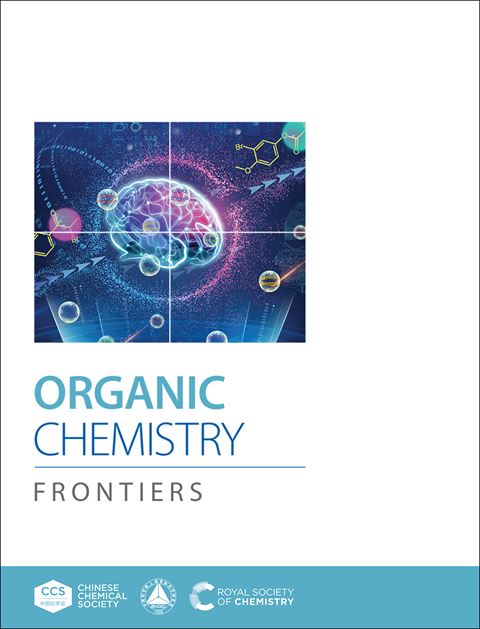NaH-Promoted One-Pot Oxidation/Aromatization and C-3H Chalcogenation of Indoline: Atmospheric Control-Based Selective Intermediates
IF 4.6
1区 化学
Q1 CHEMISTRY, ORGANIC
引用次数: 0
Abstract
A sub-stoichiometric sodium hydride promoted strategy with diselenides and disulphides, has been devised for the one-pot cascade oxidation/arometization and regioselective C-3 selenium/sulfenylation of indolines under transition metal-free conditions. The newly introduced protocol facilitates the synthesis of C-3 chalcogenated indoles with exceptional flexibility and efficiency. The chalcogenation reaction was successfully performed under both aerobic and inert conditions leading to the formation of C-3 chalcogenated indoles via two different intermediates. The mechanistic insights were derived from various controlled experiments and trapping of reaction intermediates for both the conditions, structurally varifying them by spectral analysis. The preponderance of the radical route was validated by EPR spectroscopy and radical quenching experiments. A wide variety of 3-arylthioindoles and 3-arylselenylindoles containing electron-releasing and withdrawing substituents were obtained in high to excellent yields with this modest and environmentally benign protocol. Additionally, post-transformation of sulfenylated derivatives has further led to the generation of diarylsulfoxide core of pharmaceutical interest. The reaction is applicable to gram scale synthesis without significant loss in product yield, indicating its application for large-scale synthesis. Interestingly, the biological evaluation of the 5-bromo-3-((4-(trifluoromethyl)phenyl)selanyl)-1H-indole and 3-((4-chlorophenyl)thio)-1H-indole revealed significant activity against rapidly growing mycobacteria (RGM).钠促进吲哚的一锅氧化/芳构化和C-3H加硫:基于大气控制的选择性中间体
在无过渡金属的条件下,采用亚化学计量氢化钠促进二硒和二硫化物的一锅级联氧化/芳香化反应和区域选择性C-3硒/亚砜化反应。新引入的方案促进了C-3硫代吲哚的合成,具有特殊的灵活性和效率。在好氧和惰性条件下,通过两种不同的中间体生成了C-3硫代吲哚。机理的见解是从各种控制实验和捕获反应中间体的两种条件下得出的,并通过光谱分析对它们进行结构变化。通过EPR光谱和自由基猝灭实验验证了自由基路径的优越性。用这种温和的环境友好的方法,以高收率获得了多种含有电子释放和撤回取代基的3-芳基硫吲哚和3-芳基硒基吲哚。此外,转化后的磺化衍生物进一步导致了二芳基亚砜的产生,这是药物研究的核心。该反应适用于克级合成,产物收率无明显损失,具有大规模合成的应用前景。有趣的是,5-溴-3-((4-(三氟甲基)苯基)selanyl)- 1h -吲哚和3-((4-氯苯基)硫)- 1h -吲哚的生物学评价显示出对快速生长分枝杆菌(RGM)的显著活性。
本文章由计算机程序翻译,如有差异,请以英文原文为准。
求助全文
约1分钟内获得全文
求助全文
来源期刊

Organic Chemistry Frontiers
CHEMISTRY, ORGANIC-
CiteScore
7.90
自引率
11.10%
发文量
686
审稿时长
1 months
期刊介绍:
Organic Chemistry Frontiers is an esteemed journal that publishes high-quality research across the field of organic chemistry. It places a significant emphasis on studies that contribute substantially to the field by introducing new or significantly improved protocols and methodologies. The journal covers a wide array of topics which include, but are not limited to, organic synthesis, the development of synthetic methodologies, catalysis, natural products, functional organic materials, supramolecular and macromolecular chemistry, as well as physical and computational organic chemistry.
 求助内容:
求助内容: 应助结果提醒方式:
应助结果提醒方式:


